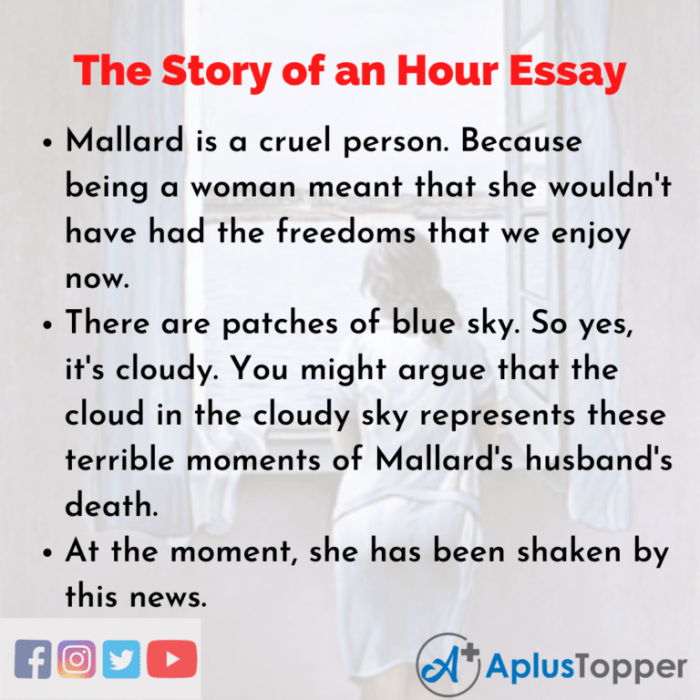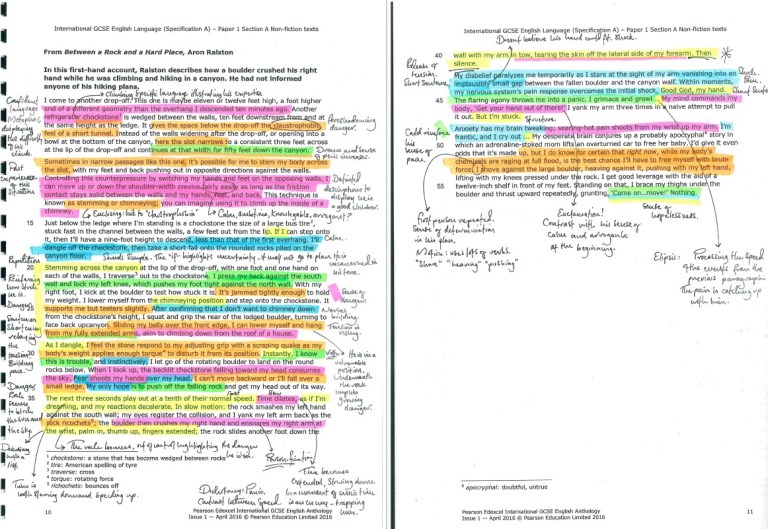The Story of an Hour Annotations PDF delves into the depths of Kate Chopin’s captivating short story, offering a comprehensive analysis of its literary elements, feminist perspectives, and historical context. This guide provides a profound understanding of the story’s enduring significance in literature and its impact on readers throughout time.
Through meticulous annotations, this PDF unravels the intricacies of the story’s symbolism, narrative structure, and character development. It illuminates the societal expectations and gender roles that shape Mrs. Mallard’s journey, challenging traditional notions of marriage and independence.
Literary Elements and Techniques

The short story “The Story of an Hour” by Kate Chopin employs various literary elements and techniques to create a powerful and evocative narrative that explores the themes of freedom, loss, and the complexities of human emotion.
Symbolism
Symbolism is a prominent feature of the story, with objects and actions taking on deeper meanings that contribute to the overall theme and atmosphere. For example, the open window represents Mrs. Mallard’s newfound freedom and escape from her oppressive marriage.
The scent of blooming lilacs symbolizes hope and renewal, while the heart condition symbolizes her physical and emotional fragility.
Narrative Structure
The story’s narrative structure is carefully crafted to create a sense of suspense and emotional intensity. The initial revelation of Mr. Mallard’s supposed death is followed by a period of reflection and introspection for Mrs. Mallard. This period of solitude allows the reader to witness her gradual transformation from grief to a sense of liberation.
Character Development and Motivation, The story of an hour annotations pdf
Mrs. Mallard is a complex and dynamic character who undergoes significant development throughout the story. Initially portrayed as a fragile and submissive wife, she gradually discovers a sense of self and independence. Her motivations are driven by a desire for freedom from the constraints of her marriage and a longing for a more fulfilling life.
Feminist Perspectives
Kate Chopin’s “The Story of an Hour” explores gender roles and societal expectations through the lens of Mrs. Mallard, a woman who initially experiences a sense of liberation upon learning of her husband’s supposed death.
The story challenges traditional notions of marriage as a restrictive institution that stifles women’s independence. Mrs. Mallard’s initial reaction of joy and relief at the prospect of being free from her marital obligations subverts the societal expectation that women should be devoted to their husbands and find fulfillment solely in domestic roles.
Portrayal of Mrs. Mallard’s Inner Thoughts and Emotions
Chopin delves deeply into Mrs. Mallard’s inner thoughts and emotions, revealing the complex and often contradictory nature of her feelings. Initially, she experiences a sense of liberation and freedom, envisioning a life beyond the confines of marriage. However, as she contemplates the implications of her newfound independence, her emotions shift to uncertainty and fear.
Mrs. Mallard’s inner monologue reveals the internal struggle between her desire for freedom and her societal conditioning. She recognizes the potential for personal growth and self-fulfillment, but also grapples with the fear of societal judgment and the unknown.
Historical and Cultural Context

The story of an hour was written in 1894 during a period of significant social and cultural change. The late 19th century marked the rise of the women’s suffrage movement, and the story reflects the changing attitudes towards women’s rights.
Social and Cultural Norms
During the Victorian era, women were expected to be subservient to men. They were denied the right to vote, own property, or pursue higher education. Marriage was seen as the only acceptable path for women, and they were expected to be completely dependent on their husbands.
Changing Attitudes
However, the late 19th century saw a growing movement for women’s rights. Women began to demand the right to vote, the right to own property, and the right to pursue higher education. The story of an hour reflects these changing attitudes.
The protagonist, Mrs. Mallard, is a woman who is finally free from the constraints of her marriage. She experiences a sense of joy and liberation that she has never felt before.
Critical Reception and Legacy: The Story Of An Hour Annotations Pdf
Upon its initial publication in 1894, “The Story of an Hour” garnered mixed critical responses. Some critics praised Chopin’s nuanced exploration of female psychology, while others condemned its unconventional portrayal of marriage and widowhood.
Evolving Interpretation
Over time, the story’s interpretation has evolved significantly. Early readings focused on the protagonist’s “feminine hysteria” and her inability to cope with her newfound freedom. However, feminist critics in the 20th century re-evaluated the story as a subversive exploration of female agency and the constraints of patriarchal society.
Enduring Impact
The story’s enduring impact on literature and popular culture is evident in its numerous adaptations, including stage plays, films, and short stories. Its exploration of grief, freedom, and the complexities of female identity continues to resonate with readers and audiences worldwide.
Adaptations and Visual Representations

The short story “The Story of an Hour” has been adapted into various media, including film, television, and theater. These adaptations have interpreted and reimagined the original story in different ways, offering unique perspectives on its themes and characters.
Film Adaptations
- The Awakening(1952): This film adaptation, directed by Clarence Brown, stars Bette Davis as Louise Mallard. It expands on the original story by adding a love triangle and exploring Louise’s inner struggles more deeply.
- The Story of an Hour(1984): This short film adaptation, directed by Jane Campion, remains closer to the original story and provides a more intimate and introspective portrayal of Louise’s experience.
- A Woman’s Story(2009): This independent film adaptation, directed by D.W. Brown, updates the story to a modern setting and focuses on the challenges faced by women in contemporary society.
Television Adaptations
- The Twilight Zone(1964): This episode of the classic television series adapts the story and explores the themes of grief, loss, and the power of imagination.
- American Horror Story: Asylum(2012): This episode of the television series includes a reimagined version of the story set in a mental institution.
Theater Adaptations
- The Story of an Hour(1993): This one-act play adaptation by A.R. Gurney premiered off-Broadway and explores the story’s themes of marriage, independence, and female empowerment.
- An Hour of Freedom(2018): This musical adaptation by Richard Rodgers and Oscar Hammerstein II premiered on Broadway and features a more upbeat and optimistic tone.
These adaptations have varying strengths and weaknesses. Some, like The Awakening, offer a more elaborate and emotionally charged interpretation of the story, while others, like The Story of an Hour(1984), provide a more faithful and nuanced adaptation. Ultimately, the best adaptation for any individual viewer will depend on their personal preferences and interpretations of the original story.
Teaching Resources
The story of an hour is a valuable resource for educators who want to teach literary analysis, feminist theory, and historical context in the classroom. The story is accessible to students of all ages and can be used to teach a variety of literary concepts.
One way to use the story in the classroom is to teach literary analysis. The story is a well-crafted example of a short story, and it can be used to teach students how to identify and analyze literary elements such as plot, character, setting, and theme.
Lesson Plans
There are a number of lesson plans available online that can help educators teach the story of an hour in the classroom. These lesson plans provide step-by-step instructions on how to teach the story, as well as discussion questions and activities that can be used to help students understand the story.
Discussion Questions
Some discussion questions that can be used to teach the story of an hour include:
- What is the significance of the title of the story?
- How does the story explore the theme of female independence?
- What are the different ways in which the story can be interpreted?
Other Materials
In addition to lesson plans and discussion questions, there are a number of other materials that can be used to teach the story of an hour in the classroom. These materials include:
- Worksheets that can be used to help students analyze the story
- PowerPoint presentations that can be used to introduce the story and its themes
- Film adaptations of the story that can be used to show students how the story has been interpreted by different filmmakers
Question Bank
What is the significance of the title “The Story of an Hour”?
The title encapsulates the brevity of Mrs. Mallard’s newfound freedom and the transformative power of an hour in shaping her life.
How does the story explore feminist perspectives?
The story challenges societal expectations of women, examines the constraints of marriage, and empowers Mrs. Mallard to embrace her own desires and independence.
What is the historical context of the story?
Written in 1894, the story reflects the changing attitudes towards women’s rights and the emergence of the women’s suffrage movement.